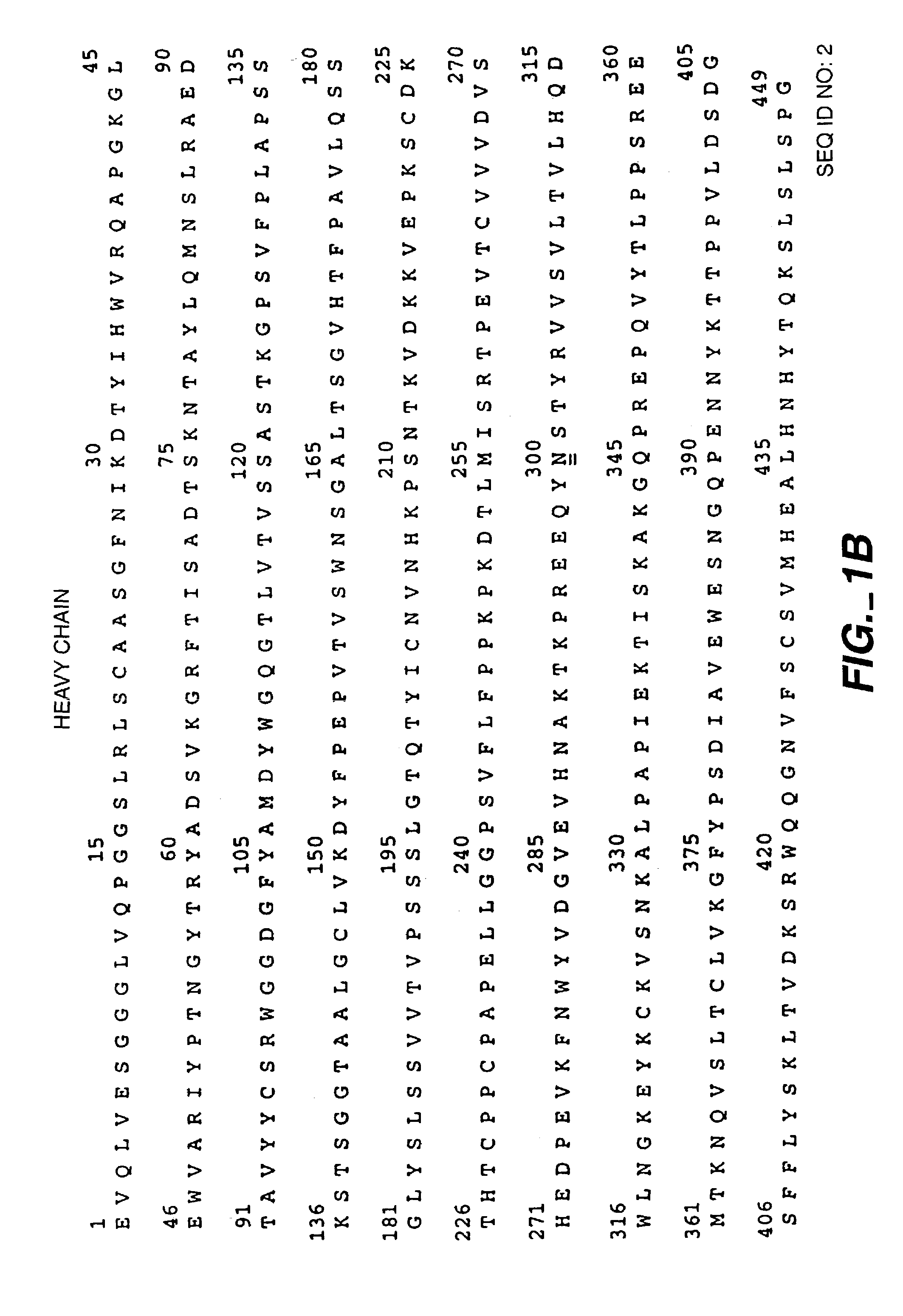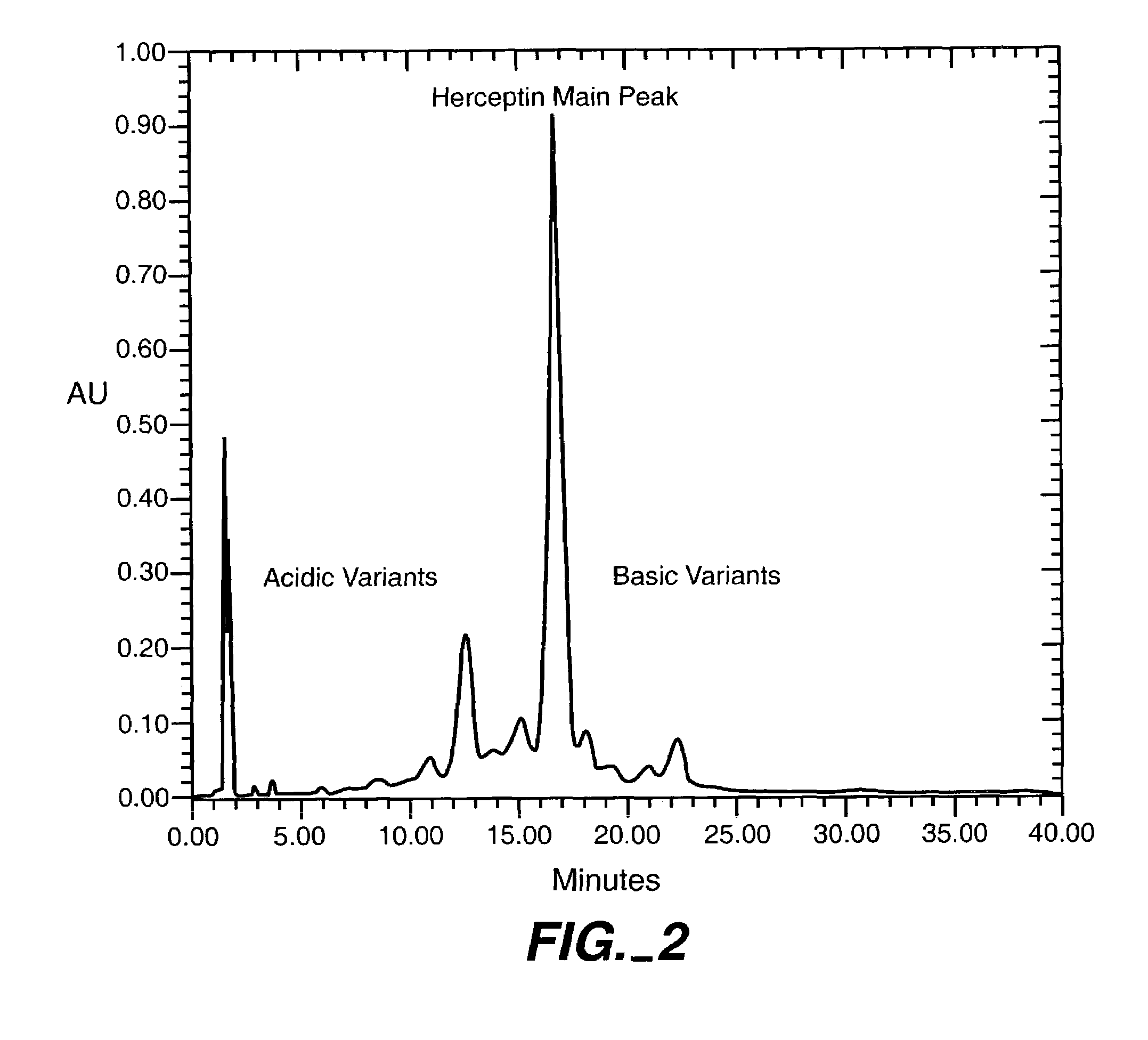Stabilizing polypeptides which have been exposed to urea
a technology of urea and polypeptides, which is applied in the direction of antibody medical ingredients, peptide/protein ingredients, drug compositions, etc., can solve the problems of difficult removal of subcellular fragments, and the formidable challenge of human use as a human therapeuti
- Summary
- Abstract
- Description
- Claims
- Application Information
AI Technical Summary
Benefits of technology
Problems solved by technology
Method used
Image
Examples
example 1
Resolution of Trastuzumab and its Variants
[0088]Trastuzumab (HERCEPTIN®) is a recombinant, humanized antibody directed against the HER2 antigen that is approved for the treatment of metastatic breast cancer.
[0089]The stability of Trastuzumab can be determined using a cation exchange (Dionex) assay for resolution of Trastuzumab into its variants through elution in a 15-100 mM NaCl gradient. A typical Trastuzumab ion exchange profile is shown in FIG. 2.
[0090]The logs of viral inactivation for Trastuzumab purified using Protein A chromatography, hydrophobic interaction chromatograph (HIC), and anion exchange chromatography are shown in the following table.
[0091]
TABLE 1Logs of Viral InactivationMVMSV40StepRetrovirus(Adventitous)(Adventitous)Protein A3.52.52.5Low pH5.6—SP Sepharose2.4—Q Sepharose3.75.52.5HIC1.4—
example 2
Stability of Trastuzumab in Urea
[0092]3M urea at pH 5.6 was thought to give at least 4 logs of viral inactivation. To achieve this, a 7.5M stock of urea was prepared and deionized. This was added to Trastuzumab Protein A elution pool to yield a final concentration of 3M. This pool was then adjusted to pH 5.6. At regular intervals, samples were analyzed by the Dionex assay. Urea was found to degrade Trastuzumab at room temperature as determined by the reduction in the “main peak” and increase in acidic variants (FIG. 3). With time, the main peak was converted into acidic variants. Analyzing the drop in main peak area was deemed a suitable method of measuring stability.
[0093]At pH 5.6, Trastuzumab was more stable in a citrate / Tris buffer than an acetate / Mops buffer (FIG. 4).
[0094]As pH was decreased, an improvement in stability was observed (FIG. 5).
example 3
Improving Trastuzumab Stability
[0095]Various scavengers of free cyanate ions were screened for their ability to stabilize Trastuzumab in the presence of urea. The scavenger was desirably an amine containing solution which was readily soluble in urea. The scavengers tested were: Tris HCl, Bis Tris, Tricine, Bis Tris Propyl, Arginine, Glycine (see FIG. 6). The cost, pool conductivity, and released material status of these scavengers is reflected in the following table.
[0096]
TABLE 2Potential ScavengersCost ofPool500 mM / L StockConductivityReleasedMolecule($)(mS / cm)MaterialGlycine0.334.5YesArginine1.9215.5YesTris HCl1.9816.4YesTricine7.174.2YesBis Tris—14.5NoBis Tris—23.0NoPropyl
[0097]Glycine was selected as the preferred due to its effectiveness at maintaining the main peak area, its high solubility, low conductivity at high concentrations and low cost relative to other scavengers. Glycine is also a released material (i.e. it is approved by Quality Control for GMP).
PUM
| Property | Measurement | Unit |
|---|---|---|
| concentration | aaaaa | aaaaa |
| pH | aaaaa | aaaaa |
| concentration | aaaaa | aaaaa |
Abstract
Description
Claims
Application Information
 Login to View More
Login to View More - R&D
- Intellectual Property
- Life Sciences
- Materials
- Tech Scout
- Unparalleled Data Quality
- Higher Quality Content
- 60% Fewer Hallucinations
Browse by: Latest US Patents, China's latest patents, Technical Efficacy Thesaurus, Application Domain, Technology Topic, Popular Technical Reports.
© 2025 PatSnap. All rights reserved.Legal|Privacy policy|Modern Slavery Act Transparency Statement|Sitemap|About US| Contact US: help@patsnap.com



